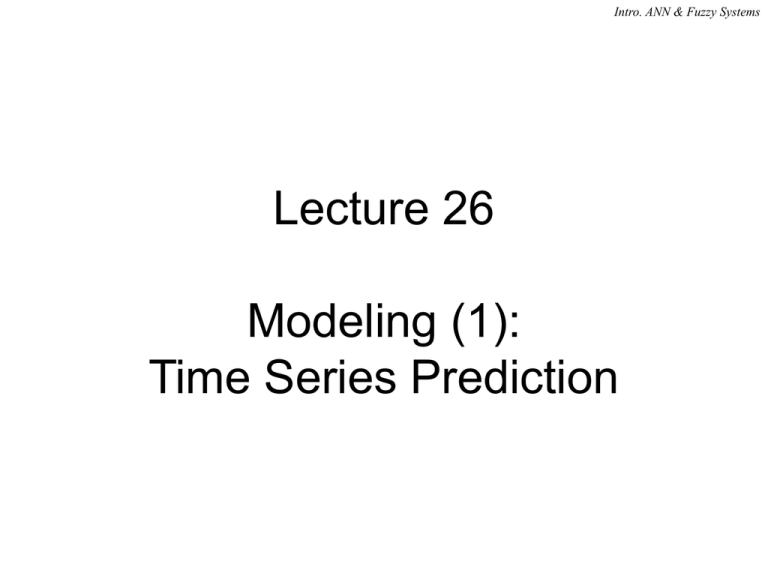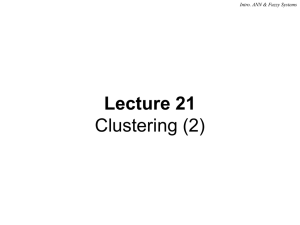Lecture 26 Model
advertisement

Intro. ANN & Fuzzy Systems
Lecture 26
Modeling (1):
Time Series Prediction
Intro. ANN & Fuzzy Systems
Outline
• Time series models
• Linear Time Series Models
– Moving Average Model
– Auto-regressive Model
– ARMA model
• Nonlinear Time Series Estimation
• Applications
(C) 2001-2003 by Yu Hen Hu
2
Intro. ANN & Fuzzy Systems
Time Series
• What is a time series?
– A scalar or vector-valued
function of time indices
• Examples:
– Stock prices
– Temperature readings
– Measured signals of all
kinds
• What is the use of a time
series?
– Prediction of future time
series values based on past
observations
(C) 2001-2003 by Yu Hen Hu
Modeling of a time series
Values of a time series at successive
time indices are often correlated.
Otherwise, prediction is impossible.
Most time series can be modeled
mathematically as a wide-sense
stationary (WSS) random process.
The statistical properties do not
change with respect to time.
Some time series exhibits chaotic
nature. A chaotic time series can be
described by a deterministic model
but behaves as if it is random, and
highly un-predictable.
3
Intro. ANN & Fuzzy Systems
Time Series Models
• Most time series are
sampled from continuous
time physical quantities at
regular sampling intervals.
One may label each such
interval with an integer
index. E.g.
{y(t); t = 0, 1, 2, …}.
• A time series may have a
starting time, say t = 0. If so,
it will have an initial value.
• In other applications, a time
series may have been run
for a while, and its past value
can be traced back to t= .
(C) 2001-2003 by Yu Hen Hu
• Notations
– y(t): time series value at
present time index t.
– y(t1): time series value one
unit sample interval before t.
– y(t+1): the next value in the
future.
• Basic assumption
– y(t) can be predicted with
certainly degree of accuracy
by its past values {y(tk); k
> 0} and/or the present and
past values of other time
series such as {x(tm); m
0}
4
Intro. ANN & Fuzzy Systems
Time Series Prediction
• Problem Statement
Given {y(i); i = t1, …}
estimate y(t+to), to 0 such
that
2
C E e(t to )
E y (t to ) yˆ (t to )
2
is minimized.
when to = 0, it is called a 1step prediction.
Sometimes, additional time
series {u(i); i = t, t1, …}
may be available to aid the
prediction of y(i)
(C) 2001-2003 by Yu Hen Hu
• The estimate of y(t+to) that
minimizes C is the
conditional expectation given
past value and other relevant
time series.
yˆ (t to )
E y(t to ) | { y(i)}ti 1 ,{u (i)}ti
• This conditional expectation
can be modeled by a linear
function (linear time series
model) or a nonlinear
function.
5
Intro. ANN & Fuzzy Systems
A Dynamic Time Series Model
• State {x(t)}
– Past values of a time series
can be summarized by a
finite-dimensional state
vector.
y(t)
Time series model
• Input {u(t)}
States x(t)
– Time series that is not
dependent on {y(t)}
y(t ) f ( x(t ), u(t ))
• The mapping is a dynamic
system as y(t) depends on
both present time inputs as
well as past values.
(C) 2001-2003 by Yu Hen Hu
memory
Input
u(t)
x(t) = [x(t) x(t1) … x(t p)]
consists past values of {y(t)}
u(t) = [u(t) u(t1) … u(t q)]
6
Intro. ANN & Fuzzy Systems
Linear Time Series Models
•
•
y(t) is a linear combination of x(t) and/or u(t).
White noise random process model of input {u(t)}:
–
–
•
E(u(t)) = 0
E{u(t)u(s)} = 0 if t s; = s2 if t = s.
Three popular linear time series models:
1. Moving Average (MA) Model:
M
y (t ) b(m)u (t m)
m 0
2. Auto-Regressive (AR) Model:
N
y (t ) a (n) y (t n) u (t )
n 1
3. Moving Average, Auto-regressive (ARMA) Model:
N
M
n 1
m 0
y (t ) a (n) y (t n) b(m)u (t m)
(C) 2001-2003 by Yu Hen Hu
7
Intro. ANN & Fuzzy Systems
Moving Average Model
M
y (t ) b(m)u (t m)
•
•
m 0
Cross correlation function
R yu (i ) E y (t )u (t i )
•
M
b(m) E u (t m)u (t i )
m 0
s 2b(i ) if 0 i M ,
otherwise.
0
•
•
An MA model is recognized by
the finite number of non-zero
auto-correlation lags.
{b(m)} can be solved from
{Ry(k)} using optimization
procedure.
Example: If {u(t)} is the stock
price, then
u (t ) u (t 1) u (t 2) u (t 3)
4
is a moving average model – An
average that moves with
respect to time!
y (t )
Auto-correlation function:
Ry (k ) E y (t ) y (t k )
2 M |k |
s
b(m)b(m k ) | k | M ;
m
0
0
| k | M .
(C) 2001-2003 by Yu Hen Hu
8
Intro. ANN & Fuzzy Systems
Finding MA Coefficients
•
•
•
•
Problem: Given a MA time
series {y(t)}, how to find {b(m)}
withtout knowing {u(t)}, except
the knowledge of s2?
One way to find the MA model
coefficients {b(m)} is spectral
factorization.
Consider an example:
y (t ) b(0)u (t ) b(1)u (t 1)
•
Given {y(t); t = 1, …, T},
estimate auto-correlation lag
•
Rˆ (k )
•
1 T k
y(t ) y(t k )
T k t 1
For this MA(1) model, R(k)0 for
k > 1.
(C) 2001-2003 by Yu Hen Hu
Power spectrum
SYY ( z ) B( z ) B(1 / z )
*
R(k ) z
1
k
b(0) z b(1) b(0) b(1) z *
z
1
B(z)
B(1/z*)
zeros
b(1)/b(0)
(b(1)/b(0))*
poles
0
Spectral factorization:
– Compute S(z) from {R(k)} and
factorize its zeros and poles to
construct B(z)
•
Or comparing the coefficients of
polynomial and solve a set of
nonlinear equations.
9
Intro. ANN & Fuzzy Systems
Auto-Regressive Model
N
y (t ) a(n) y (t n) u (t )
n 1
E y (t ) 0, E y (t )u (t ) s 2
Hence,
R( 0 ) R(–1 ) R(–N) 1 σ 2
R( 1 ) R( 0 ) R(–N+1 ) –a( 1 ) 0
=0
R(N)
R(N–
1
)
R(
0
)
–a(N)
0
R
R y (k ) E y (t ) y (t k )
N
E u (t ) y (t k ) a(n) E y (t n) y (t k )
•
n 1
N
s (t k ) a(n) R y (k n)
2
n 1
This leads to the Yule - Walker equation :
Ra s 2 1 0 0 s 2 e
T
or in matrix form :
(C) 2001-2003 by Yu Hen Hu
•
a
s 2e
Ry(m) is replaced with R(m) to
simplify notations.
R is a Töeplitz matrix and is
positive definite. Fast Cholesky
factorization algorithms such as
the Levinson algorithm can be
devised to solve the Y-W
equation effectively.
10
Intro. ANN & Fuzzy Systems
Auto-Regressive, Moving Average
(ARMA) Model
N
M
n 1
m 0
y (t ) a (n) y (t n) b(m)u (t m)
•
•
A combination of AR and MA
model.
M
Denote v(t ) b(m)u (t m)
m 0
Then
E y (t s )v(t )
M
b(m) E y (t s )u (t m)
m 0
0 for s M
Thus,
R y (k ) E y (t ) y (t k )
M
N
E a(n) y (t n) b(m)u (t m) y (t k )
m 0
n 1
N
M
n 1
m 0
a(n) R y (k n) b(m) E y (t k )u (t m)
N
a(n) R y (k n) if k M .
n 1
Higher order Y-W equation
R(k 2 )
R(k 1 )
R(k)
R(k 1 )
R(k L 1 ) R(k L 2 )
(C) 2001-2003 by Yu Hen Hu
R(k–N)
R(k )
a
(
1
)
R(k 1)
R(k–N+1 )
=
a( N )
R(k L N)
R
(
k
L
)
11
Intro. ANN & Fuzzy Systems
Nonlinear Time Series Model
• f(x(t), u(t)) is a nonlinear
function or mapping:
– MLP
– RBF
• A neuronal filter
u(t)
D
u(t1)
D
• Time Lagged Neural Net
(TLNN)
– The input of a MLP network
is formed by a time-delayed
segment of a time series.
yˆ (t )
+
u(t)
f()
D
u(tM)
MLP
y(t)
+
e(t)
D
(C) 2001-2003 by Yu Hen Hu
u(t1)
D
D
u(tM)
12





